Growing Ferns Indoors
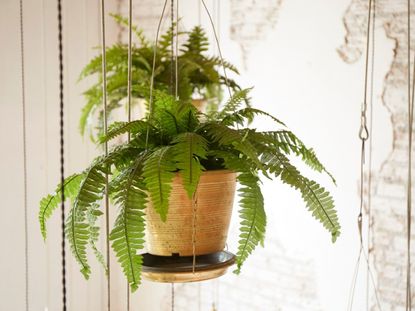

Are indoor ferns good houseplants? Our ancestors knew a thing or two about decor. Pteridomania is the name for the fern fad, with pterido being the Latin term for fern. Their popularity has waned and waxed over the decades. Adding a touch of exotica and elegance to the home, the fern as an indoor plant lends an air of lushness that other plants cannot mimic.
In the mid to late 1840s, this trend was found primarily in wealthier homes, but today houseplant lovers everywhere enjoy ferns. Ferns as indoor plants can lend a jungle or verdant forest vibe, and are a great way to bring the outdoors into the home.
Caring for Fern Plants Indoors
Despite their exotic nature, ferns are quite easy to care for, provided they are in the correct location and soil. Many exotic plants require special maintenance schedules, but ferns are a bit more forgiving.
Light
Although ferns in the wild grow in moist, shady places like forest floors, they do need some light. They thrive in dappled light, so if your indoor light is too low you may see poor growth or yellowing fronds.
Give your indoor ferns a position near a window that gets morning or late afternoon sun, and keep them away from strong sunlight, especially during the summer. Almost all fern plants prefer indirect light. Situate them by an eastern window or slightly away from sunnier areas. The delicate foliage can be burned by strong direct sun rays, but dimmer light actually improves the color and production of the fronds. If the fern is placed in a southern or western window, provide a sheer curtain to prevent the fronds from burning.
Water
As a rule, ferns need moist soil. They don’t perform well in containers if the soil is soggy, but consistent moisture is key. Add water when the soil is dry to the touch on the surface. The frequency of watering will depend on temperatures and light exposure. Shedding leaflets is a sign that the plant is too low on water. Some ferns are sensitive to chlorine -- allow tap water to off-gas and come to room temperature before watering the plant.
Temperature & Humidity
Indoor ferns don’t respond well to drafty conditions or extreme temperatures. Ferns prefer daytime temperatures between 65-75 degrees F (18.3-24 C) and like the temperature to be around 10 degrees cooler at night. In fact, tropical ferns survive best in homes with central heating.
Gardening tips, videos, info and more delivered right to your inbox!
Sign up for the Gardening Know How newsletter today and receive a free download of our most popular eBook "How to Grow Delicious Tomatoes."
However, ferns do enjoy moderately high humidity, which can be hard to maintain in the home interior, especially in winter. Browning and yellowing of the tips of the leaves indicates the humidity is too low. Use a humidifier to keep the humidity levels at 30-50 percent. You might also mist the leaves daily with tepid water, or place the plant on a pebble lined saucer filled with water. The water will evaporate from this humidity tray and increase the ambient humidity around the plant.
Soil
Most outdoor ferns are forest or woodland plants and have tender, delicate roots adapted to the light forest soil, which is rich in leaf mold and decayed vegetable matter. A compost that contains peat or a fibrous peat substitute with plenty of sand is best. The right compost must be free draining so that the roots never get waterlogged.
Ferns prefer humic-rich, slightly moist soil. Purchased potting soils are usually sufficient. The soil mixture should contain some sphagnum or peat moss for moisture retention but it also needs to be well draining. For homemade soil, mix equal parts of peat moss, sand and garden soil. It’s best to sterilize this soil mix by baking it to kill off any pathogens.
Fertilizer
Fern plants indoors don’t need to be repotted frequently but they do need nutrients added to the soil. Fertilize lightly in spring or when the leaves are yellowing. Use a balanced liquid houseplant fertilizer diluted by half. Do not feed an indoor fern in the fall through winter but instead, give it time to rest.
Problems, Pests & Diseases
A fern houseplant will not be as vulnerable to insects as those grown outdoors. Plants brought outside may get scale, mealybugs, or spider mites. The most common problems stem from low moisture and humidity levels, but they can also occur if the soil is left boggy.
Use a soil meter if necessary to provide adequate amounts of water to the plant. Over-fertilized ferns will develop brown leaf tips. Ferns get dusty, which can affect their ability to respirate and photosynthesize, as well as dim their beauty. Put the plant in the shower and wash off the dust frequently.
Pruning Indoor Fern Plants
Trim off damaged or dead fronts at any time of the year. If you wish to minimize the size of the fern, take no more than one-third of the fronds off at any time.
Propagating Indoor Ferns
Fern growth springs from rhizomes in the soil. Ferns grow from spores, too, but these can be difficult to grow due to special needs in temperature, humidity, and other conditions. The easiest way to propagate a fern is through division. Use a clean, sharp blade to cut through the rhizomes and roots and repot each half separately.
Repotting Indoor Ferns
You can repot your ferns in the springtime, but only if their roots are filling the pot. Ferns don’t mind being overcrowded for a short period of time. If they aren’t quite ready for a new pot, just scrape off the top layer of compost and replace it with fresh compost. Cut off any damaged fronds to encourage new growth.
When you decide it’s time to repot them, you can divide ferns and make two plants from one. You can also grow new ferns from the powdery spores produced in little capsules. These capsules are visible as rows of rusty, brown patches on the undersides of the fronds. These will grow into a green film from which the fern will grow.
It’s a good idea to report your indoor fern every few years to give it a slightly larger container and freshen the soil. If you wish to keep the same container, divide overcrowded plants. The best time to repot is early spring.
Types of Indoor Fern Plants
While their cultural needs are similar, there are many varieties of ferns that thrive indoors. Here are just a few:
- Boston fern- Truly a classic. Often used in hanging baskets.
- Maidenhair fern- Lacy, fast growing foliage.
- Rabbit’s Foot fern- Fuzzy rhizomes drape over the side of the container.
- Japanese fern- Also known as fishtail fern, sports leathery leaves.
- Staghorn fern- Recognizable fronds that look like antlers. Often mounted.
- Bird's Nest fern - Flat wavy fronds look a bit like seaweed.
Indoor Fern Companions
Many common houseplants have the same cultural needs as ferns and make excellent companion plants. Look for plants with similar light, temperature and humidity requirements. Here are a few companions that may be good choices for your indoor fern:
- Prayer Plant
- Spider Plant
- Swiss Cheese Plant
- ZZ Plant
- Fittonias
- Tillandsias
- Bromeliads

Heather Rhoades founded Gardening Know How in 2007. She holds degrees from Cleveland State University and Northern Kentucky University. She is an avid gardener with a passion for community, and is a recipient of the Master Gardeners of Ohio Lifetime Achievement Award.
- Bonnie L. GrantWriter
-
 Grow a Bathroom Oasis: 8 Best Bathroom Plants With No Light or Low Light
Grow a Bathroom Oasis: 8 Best Bathroom Plants With No Light or Low LightSome apartment dwellers grow the best bathroom plants with no light or low light. Read how one of our favorite plant lovers does it in the big city.
By Teo Spengler
-
 "My Worst Mistake" – Gardeners Share 10 Hard-Learned Lessons
"My Worst Mistake" – Gardeners Share 10 Hard-Learned LessonsGardeners never stop learning, and sometimes our mistakes are the best teachers. But why not save time and heartache by learning from other gardeners' failures?
By Melanie Griffiths
-
 Brake Fern Houseplant Growing – Can You Grow A Brake Fern Inside
Brake Fern Houseplant Growing – Can You Grow A Brake Fern InsideThe brake fern is one of the easier ferns to grow indoors, so if you have not been successful with some others, you may want to try it.
By Raffaele Di Lallo
-
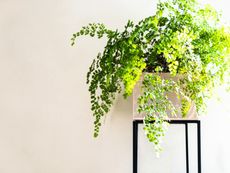 Indoor Maidenhair Fern Care – Growing A Maidenhair Fern As A Houseplant
Indoor Maidenhair Fern Care – Growing A Maidenhair Fern As A HouseplantIndoor maidenhair fern requires a little more attention than most houseplants, but with extra attention, it’s well worth the effort. Learn more here.
By Raffaele Di Lallo
-
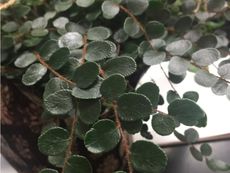 Button Fern Indoor Requirements – How To Grow Button Fern Houseplants
Button Fern Indoor Requirements – How To Grow Button Fern HouseplantsDo you want an easier-to-grow fern that doesn’t need as much humidity as other ferns, and that stays a manageable size? Then click here to learn about the button fern.
By Raffaele Di Lallo
-
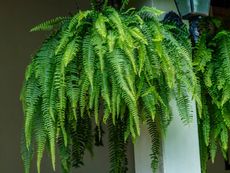 Fern In A Hanging Container: Care Of Ferns In Hanging Baskets
Fern In A Hanging Container: Care Of Ferns In Hanging BasketsFerns in hanging baskets are charming, indoors and out. Click this article for tips on growing hanging ferns so they look their best.
By Mary H. Dyer
-
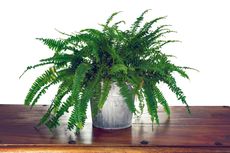 Do Indoor Ferns Purify Your Home – Learn About Purifying Fern Plants
Do Indoor Ferns Purify Your Home – Learn About Purifying Fern PlantsDo indoor ferns purify your home? A study by NASA documented the ability of indoor plants to remove a variety of harmful air pollutants commonly found indoors. And it turns out that ferns were some of the best plants for removing indoor pollutants. Learn more here.
By Raffaele Di Lallo
-
 Fertilizing Indoor Ferns – How To Feed Your Indoor Potted Ferns
Fertilizing Indoor Ferns – How To Feed Your Indoor Potted FernsShould you feed your indoor ferns? How much fertilizer do they need? Click here to learn all about fertilizing fern houseplants.
By Mary H. Dyer
-
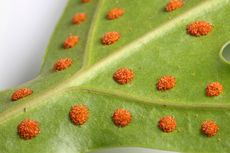 Propagating Ferns: Growing Ferns From Spores And Division
Propagating Ferns: Growing Ferns From Spores And DivisionFerns provide airy foliage and texture for the home gardener, both as indoor and outdoor plants. Propagating ferns is easiest by division, but they can also be grown from their spores. Learn more here.
By Bonnie L. Grant